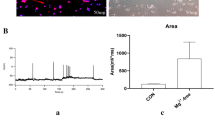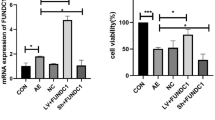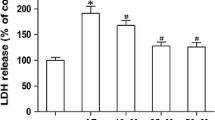Abstract
HS1-associated protein X1 (HAX-1) is a mitochondrial protein which interacts with a diverse group of molecules such as inflammatory cytokines; interleukin-1, hematopoietic lineage specific protein-1 and vimentin. It has been reported that HAX-1 may act as antiapoptotic protein in HeLa- and Jurkat cells after Fas-treatment, irradiation or serum deprivation. This underlines the evidence that HAX-1 might be involved in both receptor- and mitochondria-mediated apoptosis pathways. However, the role of HAX-1 in neuronal death induced by status epilepticus in the immature brain has not been reported. In this study, we performed a status epilepticus in rats and investigated the dynamic changes of HAX-1 expression, HtrA2 distribution and caspase-3 activation in the hippocampus. Western blot and immunohistochemistry analysis revealed that HAX-1 was expressed at very low levels in the hippocampus. Status epilepticus in the immature brain significantly induced increased cytosolic accumulation of HAX-1 in a biphasic manner, induced an upregulation of HtrA2 and enhanced caspase-3 activity in the selectively vulnerable hippocampal CA1-subfield. Taken together, these results suggested that HAX-1 is probably involved in the pathophysiology of cell death induced by epilepsy.






Similar content being viewed by others
References
Niquet J, Auvin S, Archie M, Seo DW, Allen S, Sankar R, Wasterlain CW (2007) Status epilepticus triggers caspase-3 activation and necrosis in the immature rat brain. Epilepsia 48:1203–1206
Holcik M, Gibson H, Korneluk RG (2001) XIAP: apoptotic brake and promising therapeutic. Apoptosis 6:253–261
Rami A, Bechmann I, Stehle J (2008) Exploiting endogenous anti-apoptotic proteins for novel therapeutic strategies in cerebral ischemia. Prog Neurobiol 85:273–296
Gross A, McDonnell JM, Korsmeyer SJ (1999) BCL-2 family members and the mitochondria in apoptosis. Genes Dev 13:1899–1911
Suzuki Y, Demoliere C, Kitamura D, Takeshita H, Deuschle U, Watanabe T (1997) HAX-1, a novel intracellular protein, localized on mitochondria, directly associates with HS1, a substrate of Src family tyrosine kinases. J Immunol 158:2736–2744
Yamanashi Y, Fukuda T, Nishizumi H, Inazu T, Higashi K, Kitamura D, Ishida T, Yamamura H, Watanabe T, Yamamoto T (1997) Role of tyrosine phosphorylation of HS1 in B cell antigen receptor-mediated apoptosis. J Exp Med 185:1387–1392
Carlsson G, Elinder G, Malmgren H, Trebinska A, Grzybowska E, Dahl N, Nordenskjöld M, Fadeel B (2009) Compound heterozygous HAX1 mutations in a Swedish patient with severe congenital neutropenia and no neurodevelopmental abnormalities. Pediatr Blood Cancer 53:1143–1146
Fadeel B, Grzybowska E (2009) HAX-1: a multifunctional protein with emerging roles in human disease. Biochim Biophys Acta 1790:1139–1148
Rezaei N, Chavoshzadeh Z, Alaei OR, Sandrock I, Klein C (2007) Association of HAX1 deficiency with neurological disorder. Neuropediatrics 38:261–263
Chao JR, Parganas E, Boyd K, Hong CY, Opferman JT, Ihle JN (2008) Hax1-mediated processing of HtrA2 by Parl allows survival of lymphocytes and neurons. Nature 452:98–102
Carlsson G, Melin M, Dahl N, Ramme KG, Nordenskjöld M, Palmblad J, Henter JI, Fadeel B (2007) Kostmann syndrome or infantile genetic agranulocytosis, part two: understanding the underlying genetic defects in severe congenital neutropenia. Acta Paediatr 96:813–819
Cilenti L, Soundarapandian MM, Kyriazis GA, Stratico V, Singh S, Gupta S, Bonventre JV, Alnemri ES, Zervos AS (2004) Regulation of HAX-1 anti-apoptotic protein by Omi/HtrA2 protease during cell death. J Biol Chem 279:50295–50301
Han Y, Chen YS, Liu Z, Bodyak N, Rigor D, Bisping E, Pu WT, Kang PM (2006) Overexpression of HAX-1 protects cardiac myocytes from apoptosis through caspase-9 inhibition. Circ Res 99:415–423
Lee AY, Lee Y, Park YK, Bae KH, Cho S, Lee do H, Park BC, Kang S, Park SG (2008) HS 1-associated protein X-1 is cleaved by caspase-3 during apoptosis. Mol Cells 25:86–90
Rami A, Kim M, Niquet J (2010) Translocation of the serine protease Omi/HtrA2 from mitochondria into the cytosol upon seizure-induced hippocampal injury in the neonatal rat brain. Neurochem Res 35:2199–21207
Racine RJ (1972) Modification of seizure activity by electrical stimulation. II. Motor seizure. Electroencephalogr Clin Neurophysiol 32:281–294
Suzuki Y, Imai Y, Nakayama H, Takahashi K, Takio K, Takahashi R (2001) A serine protease, Omi/HtrA2, is released from the mitochondria and interacts with XIAP, inducing cell death. Mol Cell 8:613–621
Vaux DL, Silke J (2003) Mammalian mitochondrial IAP binding proteins. Biochem Biophys Res Commun 304:499–504
Verhagen AM, Silke J, Ekert PG, Pakusch M, Kaufmann H, Connolly LM, Day CL, Tikoo A, Burke R, Wrobel C, Moritz RL, Simpson RJ, Vaux DL (2002) Omi/HtrA2 promotes cell death through its serine protease activity and its ability to antagonize inhibitor of apoptosis proteins. J Biol Chem 277:445–454
Siegelin MD, Kossatz LS, Winckler J, Rami A (2005) Regulation of XIAP and Smac/DIABLO in the rat hippocampus following transient forebrain ischemia. Neurochem Int 46:41–51
Blink E, Maianski NA, Alnemri ES, Zervos AS, Roos D, Kuijpers TW (2003) Intramitochondrial serine protease activity of Omi/HtrA2 is required for caspase-independent cell death of human neutrophils. Cell Death Differ 11:937–949
Hegde R, Srinivasula SM, Zhang Z, Wassell R, Mukattash R, Cilenti L, DuBois G, Lazebnik Y, Zervos AS, Fernandes-Alnemri T, Alnemri ES (2002) Identification of Omi/HtrA2 as a mitochondrial apoptotic serine protease that disrupts inhibitor of apoptosis protein-caspase interaction. J Biol Chem 277:432–438
Vafiadaki E, Sanoudou D, Arvanitis DA, Catino DH, Kranias EG (2007) Kontrogianni-Konstantopoulos A. Phospholamban interacts with HAX-1, a mitochondrial protein with anti-apoptotic function. J Mol Biol 367:65–79
Sharp TV, Wang HW, Koumi A, Hollyman D, Endo Y, Ye H, Du MQ, Boshoff C (2002) K15 protein of Kaposi’s sarcoma-associated herpesvirus is latently expressed and binds to HAX-1, a protein with antiapoptotic function. J Virol 76:802–816
Mirmohammadsadegh A, Tartler U, Michel G, Baer A, Walz M, Wolf R, Ruzicka T, Hengge UR (2003) HAX-1, identified by differential display reverse transcription polymerase chain reaction, is overexpressed in lesional psoriasis. J Invest Dermatol 120:1045–1051
Kang YJ, Jang M, Park YK, Kang S, Bae KH, Cho S, Lee CK, Park BC, Chi SW, Park SG (2010) Molecular interaction between HAX-1 and XIAP inhibits apoptosis. Biochem Biophys Res Commun 393:794–799
Althaus J, Siegelin MD, Dehghani F, Cilenti L, Zervos AS, Rami A (2007) The serine protease Omi/HtrA2 is involved in XIAP cleavage and in neuronal cell death following focal cerebral ischemia/reperfusion. Neurochem Int 50:172–180
Acknowledgments
We thank Prof. Jörg Stehle for continuous support to our work. This study was funded in part by research grant from the Adolf-Messer-Stiftung (Grant to Dr. A. Rami).
Author information
Authors and Affiliations
Corresponding author
Rights and permissions
About this article
Cite this article
Rami, A., Kim, M., Niquet, J. et al. Alterations in the Expression of the Anti-Apoptotic Factor HAX-1 upon Seizures-Induced Hippocampal Injury in the Neonatal Rat Brain. Neurochem Res 37, 116–125 (2012). https://doi.org/10.1007/s11064-011-0589-9
Received:
Revised:
Accepted:
Published:
Issue Date:
DOI: https://doi.org/10.1007/s11064-011-0589-9




